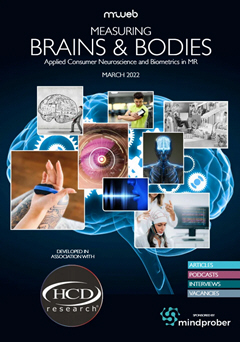'Brains & Bodies' Launch / Neuro Best Practice Guide
March 1 2022
MrWeb's special issue on 'Measuring Brains and Bodies' is launched today: viewing and downloading the 72-page pdf supplement is free: click the cover or the link below; or read on for the second part of Michelle Niedziela's article, which offers a guide to Best Practice in consumer neuroscience projects.

Brains & Bodies supplement: view and download at www.mrweb.com/cgi-bin/mrweb21.cgi?issue=neu22&email=htmlDaily
Here's part 2 of the article by Michelle Niedziela, which appears on page 32 of the pdf.
Best Practice
While it's great to be on the cutting edge of technology, it's also important to take a step back and think about the goal of your research. We suggest following a few rules/guidelines to help decide how to use neuroscience in your research:
- Start with the research question or goal.
While it is often attractive to passively measure consumers in a naturalistic environment, and exploratory research can uncover interesting findings, to get the most actionable results, consider the research question or goal. Starting with the research question will help guide the scope of the study and the approach of the method. Understanding the 'who, what, when and where' of the research helps to set parameters. For example, asking the client what they ultimately want to demonstrate with the research determines which tool best provides that specific answer. EEG would be a great option to show navigational difficulties, while implicit reaction would be a better option when exploring consumer perceptions of a brand.
Often, the research question includes action standards, which also help determine the best approach. Action standards are the performance criteria used to determine whether a product has succeeded and should be decided on before the research begins. For example, success criteria may require that the tested product outperforms a benchmark product on key elements (such as liking, purchase intent, and being perceived in a specific way or creating a specific emotional state). This helps in reporting results in a meaningful and actionable way for clients to make real business decisions based on the data.
- Always use the right tool for the right question.
Once you have the right question, it can be a lot easier to choose which research tool will best provide an answer. This is a much more productive and cost-efficient approach than starting with a tool and looking to apply it somehow. For example, if your research question is about whether a new fragrance helps to suggest that the product is more 'spiritual', facial coding will not be able to help you, but implicit reaction may be able to help. This is why it is important that your research provider be 'methodologically agnostic.' Or as we often say, a widget salesman is going to sell you a widget and not something else. If the research provider is a 'one trick pony', or only has one methodology to offer you, they likely won't be trying to tell you about the limitations of that method.
- Build a story with multiple research points.
Neuromarketers often try to say that consumers' cognitive responses can't be trusted and that neuro measures are somehow more truthful. Neuro measures are not a replacement for cognitive or more traditional measures; they don't answer the same questions. Instead of trying to make neuroscience data stand alone, supplement current research with additional insights from neuroscience and psychology. By integrating the data (either in story or through statistical modelling), it is possible to make better and more actionable, informed conclusions and interpretations.
- Keep it simple.
It's our firm belief that if you can just ask someone, then just ask them. No need for complicated or expensive tools. If the question is about liking, for example, you are much better off simply asking consumers if they like the product. Consumers are actually quite reliable at knowing whether they will purchase something or if they like something. So really that's not what the technology should be used for and it is, in fact, not great at doing such. Neuroscience and psychological methodologies should, instead, really be used for measuring items beyond liking to better understand the drivers of liking and to add something synergistically to traditional measures.
Technologies continue to improve and become faster, better and cheaper. There is no doubt that there will be increased use of neuro-methodologies in the future of consumer and market research. But with great technology comes great responsibility. More research will be needed to continue to validate new methodologies and theories and at HCD we will continue to test all new (and old) technologies for reliability and validation, ensuring that the right tool is used for the right research question.
Michelle Murphy Niedziela, PhD is a behavioral neuroscience expert in neuropsychology, psychology and consumer science. Experienced from academia (Monell Chemical Senses Center) and industry (Johnson & Johnson, Mars Chocolate) in R&D of innovation technologies and methodologies for consumer research. As VP of Research and Innovation at HCD Research, Michelle focuses on integrating applied consumer neuroscience tools with traditional methods used to measure consumer response.
SEE ALSO other pieces from this supplement published as articles on DRNO:
Neuroscience Techniques and Best Practice #1 - February 24
Podcast / video interview: Neuro-Guru Dr Michelle Niedziela - February 3 2022
Using EDA to Track Response to SquidGame - February 2 2022
Wearable Tech - Fit for MRX? - January 18 2022
Myths and Realities in Neuromarketing - January 11 2022
View the whole supplement in pdf format - download for free
All articles 2006-23 written and edited by Mel Crowther and/or Nick Thomas, 2024- by Nick Thomas, unless otherwise stated.
